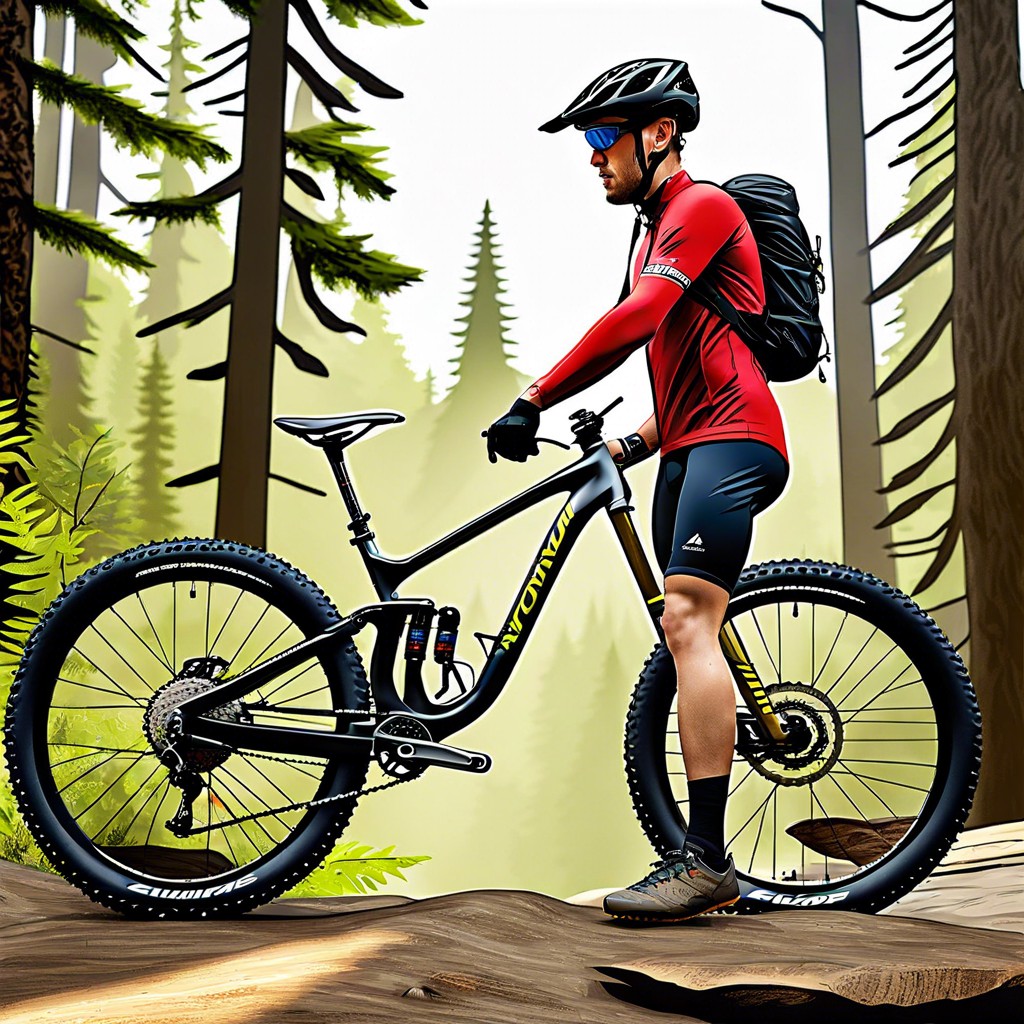Selecting the proper mountain bike size is crucial for comfort and performance; this guide will help you determine the appropriate frame size based on your height and riding style.
Key takeaways:
- Use a mountain bike size chart to find your recommended frame size.
- Consider your leg inseam length for a precise fit.
- Adjustments may be needed based on body proportions.
- Test ride bikes closest to your recommended size.
- Individual comfort and riding style are important factors to consider.
Mountain Bike Size Chart

A mountain bike size chart is a reference that matches rider height to bike frame size. Typically, these charts list heights in inches or centimeters alongside the corresponding frame size, which may be expressed in inches, centimeters, or as a general size descriptor like small, medium, or large. Here are some key points to help you interpret a mountain bike size chart:
- Height Match: Find your height on the chart to see the recommended frame size. It’s a starting point, not a definitive answer.
- Leg Inseam: For a more precise fit, compare your leg inseam length to the standover height of the bike, ensuring there’s clearance.
- Adjustments: The chart assumes average proportions; those with longer or shorter limbs may need to adjust the bike or select a different size.
- Demo Rides: If possible, test ride bikes in the sizes closest to your chart recommendation to feel what suits you best.
Remember that individual comfort and riding style are as critical as the numbers on a chart. A proper fit enhances control, comfort, and performance on the trails.
How Are Mountain Bikes Sized?
Mountain bikes come in standard sizes typically denoted as small (S), medium (M), large (L), and extra-large (XL). However, some manufacturers also include extra-small (XS) and extra-extra-large (XXL) sizes. These labels correspond to a range of frame sizes, measured in inches (in) or centimeters (cm), which indicate the length of the seat tube.
Unlike road bikes which are often measured from the center of the bottom bracket to the top of the seat tube, mountain bikes are frequently sized based on the actual seat tube length. This different sizing standard accounts for the variation in geometry needed to tackle off-road terrain.
Frame size isn’t the only consideration, though. Rider fit also depends on anatomy and personal preference. For example, two cyclists of identical height might prefer different sized frames due to leg and torso length variations. Intended use and the specific type of mountain biking—such as cross-country, all-mountain, or downhill—can also influence size preference due to differences in geometry, like head tube angle and reach.
To aid in sizing, manufacturers also offer size charts that correlate rider height to bike size, providing a solid starting point for choosing the correct frame. Nevertheless, these charts should be seen as guidelines rather than definitive directives, as individual comfort and riding style are paramount.
To ensure the best fit, a test ride and consultation with a bike fitting expert can be invaluable. They will consider all factors, such as saddle height, standover height, and the distance between the seat and the handlebars, to refine sizing and ensure optimal control and comfort on the trails.
Mountain Bike Geometry Measurements
Understanding a mountain bike’s geometry is crucial to selecting the right size. Geometry refers to the various lengths and angles that define how the bike will handle and fit a rider. Here are some key measurements to consider:
**Reach:** This is the horizontal distance from the bottom bracket to the center of the head tube. A longer reach provides a more stretched-out riding position, which is better for stability at higher speeds.
**Stack:** The vertical distance from the bottom bracket to the top of the head tube. A higher stack makes for a more upright riding position, enhancing comfort.
**Head Angle:** The angle of the front fork dictates steering sensitivity. Slacker angles, closer to the horizontal, offer stability on descents, while steeper angles allow for quick, nimble steering.
**Seat Tube Length:** While this used to be the primary measurement for bike size, it is less definitive on its own due to varying frame designs. It indicates the length of the post from the bottom bracket to the top of the seat tube.
**Chainstay Length:** This impacts how the bike accelerates and climbs. Shorter chainstays can make the bike feel more responsive and easier to lift the front wheel.
When comparing bikes, note these dimensions as they directly affect the feel and fit of the bike. Matching your body proportions and riding style to these measurements will guide you towards the correct mountain bike size.
What Is the Right Size Bike for Me?
Determining the correct mountain bike size hinges on several factors, with rider height being the primary consideration. Height correlates with frame size; most manufacturers provide size charts correlating rider height to small, medium, large, or extra-large frames. However, inseam measurement is equally important as it affects standover height, ensuring there’s enough clearance between the rider and the top tube when standing flat-footed.
Arm and torso length also play a role in finding the ideal fit. A bike’s reach – the distance from the bottom bracket to the top-center of the head tube – affects how stretched out you will be while riding. It’s a crucial measurement for comfort and control, particularly on longer rides or technical trails.
Another factor is your riding style and preferences. Aggressive riders may prefer a larger bike for stability and control at speed, while those valuing maneuverability might opt for a smaller size.
To sum up, the right size mountain bike is one that matches your height, accommodates your inseam for standover height, complements your arm and torso length for reach, and aligns with your riding style. It is recommended to test ride different sizes to find the best fit before making a purchase.